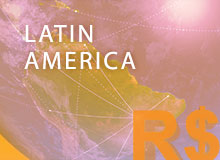In recent years, the government of Colombia has faced several obstacles in its attempts to catalyze socioeconomic progress, not the least of which has been working to end a drug war and regain control of most of the territory that had been lost to guerrilla groups. However, as Colombia enters a phase of economic stability and growth, it faces yet another enormous challenge: offering high-quality education to its citizens.
All education systems share a common goal: to give their citizen-beneficiaries broad access to a quality education. Other cultural and structural similarities notwithstanding, the Colombian education system stands in stark contrast to most other Latin American countries. In Colombia, for-profit education is forbidden by law. Consequently, the task of providing access to quality education lies exclusively in the hands of the government and private, not-for-profit institutions. Given this scenario and the experience of other emerging economies, is there an opportunity for Colombia to reexamine the role of the private sector in its quest to continue improving educational quality and access?
Gains in Access
Colombia has made remarkable advances in expanding the capacity of its schools, especially at the primary and secondary levels. According to UNESCO, in 1985, just 65.5% of eligible students were enrolled in primary school. Today, that figure is closer to 90%. Nevertheless, these gains have been tempered by continued struggles to reach students in rural areas. Moreover, the quality of education remains unevenly distributed, particularly in nonurban areas and resource-poor jurisdictions.
Some experts also question the reliability of these optimistic figures. Kattya De Oro Genes, education advisor for the Colombian National Planning Department, has said that, because public funds are allocated to municipalities based on access metrics, this “creates a perverse incentive for schools to eventually over-report the number of enrolled students, which could mask real figures.”
There is also a discrepancy in access to education for different age groups. The government has been much more successful in expanding access within primary schools, with the situation being skewed negatively at the higher grades. According to Carlos Alberto Casas Herrera, a professor at the University of Los Andes Education Research and Formation Center, “out of 100 students [who] start primary education in Colombia, only 40 will finish the 11th grade. Out of those, 10 will enter the university, and only five will graduate.”
Despite these qualifiers, Colombia has dramatically and unquestionably expanded access to primary and secondary schools, according to education experts. Improvements in quality, on the other hand, have been harder to attain. While primary and secondary education is fully subsidized by the government, there are also many privately owned, not-for-profit schools. Tuition can be substantial for these schools, which often offer a far-higher quality of education — in both curriculum and pedagogy — than can be found in public schools. The gap that is created, and the fact that high-quality education is available only to upper-income families, eventually reinforce the social inequalities that characterize Colombia today. Furthermore, the quality, and access, differential is present not only across social strata, but also geographically. Because violence in Colombia is more prevalent in the remote rural areas, there are fewer schools present and even fewer good teachers willing to accept postings to those areas.
The government has taken other crucial steps to improve access to, and the quality of, education in Colombia. In 2007, an “Encuesta nacional de la deserción” (“National Survey on Desertion”) was commissioned to investigate the reasons for students’ high drop-out rates after primary school. The consulting firm McKinsey was also hired to look into the quality of the teaching force and at ways to incentivize teachers in public schools. Nevertheless, efforts to implement a system of teacher evaluations and variable compensation have been strongly opposed by FECODE, the teachers’ union.
To some extent, the government has tried to circumvent this problem by adopting two different models of school administration: concessions and partnerships. Under the former model, the government “outsources” management of the school’s infrastructure to a private institution. Under the latter model, the government pays tuition costs at a privately owned school. These models allow for some flexibility in teacher compensation and hiring policies because the teachers are not government employees. “These are the legal frameworks that have allowed us to get our foot in the Colombian public educational system despite the inflexibility of the purely public system,” noted Veronica Puech, CEO of Enseña por Colombia, a recently created nonprofit organization (based on the Teach for America model) aimed at improving the public education system by recruiting graduates and young professionals to teach in high-need public schools for two years. Puech added that these models have faced strong opposition from the teachers’ union, and thus far have had only a limited reach.
Other government efforts include a series of nationwide standardized tests –formerly named for the Colombian Institute for Tertiary Education (ICFES) but renamed recently as SABER (the Spanish word meaning “to know”) — that are administered several times over a student’s academic career. These tests are used as nationwide gauges of education quality and have enabled education officials to establish budgetary and investment priorities. While the results of the tests are reliably indicative of student performance in any given year, constant changes in their formats make it futile to compare performance across years, ultimately nullifying the tests’ ability to measure curricular progress in the long term.
The confluence of efforts has generated skepticism that the government is within sight of guaranteeing universal access to quality K-12 education for all Colombians. De Oro Genes points out that one way for the government to achieve further development in terms of quality education and advancement in global education rankings is to exponentially increase its budget allocation. “Many people note the nominal increase in public education spending recently, but few realize that on relative terms, there has been no increase from 3% of the GDP, a figure which is low relative to other countries,” she said.
With the efficiency of government spending being called into question by various constituents, it seems that channeling more resources toward the system would be a logical next step. Thus far, government actions at K-12 have been relatively successful, even without the presence of the private, for-profit sector. Considering the nature of the remaining issues in quality and the demographic and economic profiles of those who are still not being reached by the current system, it does not appear that profit-seeking private companies would be sufficiently motivated to enter the market at this level.
Higher Education: A Failed Reform Attempt
Higher education in Colombia presents different challenges. Here, the system reaches a bottleneck, and aspiring tertiary-level students still face a drastic lack of access. Current estimates indicate that 3.2 million secondary-school graduates do not go on to higher education — not for lack of ability, but for lack of opportunity. According to the 2003 Colombian Household Survey, only 11% of youth between the ages of 18 and 24 were out of school because they were not interested in studying. In other words, potentially 89% — or 3.5 million — of-age students would pursue a tertiary education if given the chance.
To provide a sense of scale, the 32 public universities in Colombia combined have only 600,000 available enrollment seats. Furthermore, the private, not-for-profit universities catering mostly to the country’s elite increase access only incrementally due to their limited quantity and capacity. As a result, the vast majority of the public simply does not have access to higher education.
Governmental directives account for part of this conundrum. The Ley 30 (Law 30) of 1992 regulates the financial structure of public universities and strictly prohibits for-profit companies and institutions from entering the market. As a result, higher-education financing in Colombia is inequitable and insufficient. Today, Casas says, “50% of the public resources designated for tertiary education are sent to only three universities.” Confronted with this inequity, many public universities have a hard time expanding their matriculation capacities or even maintaining their existing infrastructures. With such restricted resources, even traditionally high-performing public universities are facing increasing gaps in quality vis-à-vis top private universities whose generous funding and exorbitant tuition fees afford them the luxury of space and facilities. For practical reasons, since there is a huge, untapped market demand for higher education — and the public sector lacks the resources to expand access — a possible recourse lies in permitting the private sector to step in and fill the void.
Recognizing these challenges and opportunities, in 2010 the Santos government proposed a comprehensive reform to Ley 30. In its initial stages, this reform was intended to partner private companies with public universities to bring about initiatives that would improve infrastructure in the latter and, more crucially, fund research and innovation by the academic community that would eventually generate resources dedicated to education. It was also aimed at ensuring the autonomy of universities in internal resource allocation and relaxing the ban on for-profit universities entering the higher-education market.
This last, polemic measure was inspired in part by the success of other Latin American countries in addressing problems of access. For example, by involving for-profit higher-education institutions, Brazil has increased the number of university students from 1.8 million to nearly six million over the last 12 years, 75% of whom attend for-profit institutions. Along these lines, the Santos government had hoped to open the Colombian market to these profit-oriented private universities, which would be able to circumvent the government’s budget constraints and achieve large-scale access with funding from external investors.
Unfortunately, the move proved to be too radical; Colombian society, students and teachers’ unions reacted adversely to the government’s proposal, ultimately curtailing the reform. Some would argue that the opposition had ideological roots: Many believe education is a fundamental human right under the mandate and burden of the state and are thus wary of mingling public and private resources and — perhaps more worrisome — interests.
Second, while acknowledging Brazil’s advances in expanding access, various interest groups in Colombia did not necessarily want to replicate the Brazilian model. Much of Brazil’s success has resulted from the massive proliferation of low-cost universities, which are typically not known for their quality of teaching or research. In fact, these universities are known for their relative lack of pedigree, compared to the leading public institutions, which remain as competitive and as exclusive as ever. Using Brazil as a cautionary tale, interest groups argued that quality was paramount, and the presence of for-profit institutions would provide access at the expense of quality.
Finally, many criticized the manner in which the Santos government neglected to address the civil society’s valid concerns in the process of presenting its reform agenda. As Casas has noted, “The issue was not the changes themselves, but the way that they were proposed and the government’s failure to address certain critical concerns.”
Smarter Regulation: A Possible Way Forward?
Two years later, the controversy has subsided, and it is now an opportune moment for the Colombian government to reopen a constructive debate on how best to reposition Ley 30 to facilitate its worthwhile goals. Many of the concerns raised earlier by various interest groups could be addressed through more creative regulation. For example, a regulatory framework could be developed to attract investors seeking profitability from tertiary education while ensuring that the overall quality of the education system is sustained. At that point, remaining critics might still argue that for-profit universities will never reach the top tier in terms of teaching or research quality. However, that is not such a foreboding reality. Incubating world-class pedagogy and research at every university is a desirable long-term goal, but the critical short-term target is to ensure that people who would otherwise not have access can pursue their studies, thereby directly increasing the country’s skilled human capital.
One important element of this updated framework could be Colombia’s solid track record in standardized testing. Tests can be used not only to track quality across institutions, but also to monitor and sanction universities that do not meet quality standards. In addition, Colombia could make it compulsory for all its universities to adhere to the certification standards of objective, international accreditation bodies, so there would be clear and globally competitive guidelines by which higher-education institutions would have to operate.
Expanding access to tertiary education without compromising quality is critical for ensuring that the education system attains its goals for both the students and for the country. In the short-to-medium term, a well-designed regulatory framework can help. But over the long term, the market would naturally self-regulate and exclude private universities with low returns for its graduates in the labor market. Therefore, if Colombian universities can provide an affordable education and enable the students to secure better jobs after graduation, as has happened in other countries, the students will pursue higher education. In short, the aperture of higher education to market forces, within the confines of smart regulation, would be an efficient and effective way to expand access.
The Colombian government has made great strides in expanding the country’s education system. This is particularly visible in primary and secondary education. Key challenges remain, but, fortunately, they are within the scope of what the government can do. Access is widely recognized as the main problem for tertiary education, and the government has signaled its willingness to raise the flag and ask for help from the private sector.
This pattern is consistent with a key trend found in other emerging markets, where the demand for education and increased investments in human capital have attracted private investors seeking profit, especially in the higher-education sector. To follow this trend to its final step — i.e., to allow for-profit education — the government must align society’s support with its political goals. Apart from the more traditional argument of how private tertiary education can expand access, Colombia needs to emphasize how this can be accomplished in a balanced way, without diluting quality extensively. International private universities can support internationalization and the exchange of professors; and private companies can finance laboratories, research and innovation. While purely social-related research and innovation could still be the purview of the government and public institutions, the inclusion of the private sector in the production of knowledge can only benefit the Colombian economy and society. Ultimately, all the parties would contribute to the creation of a successful cycle, where private-sector players help the government fill gaps in the educational system, grow sustainably with profit orientation and generate a positive net social impact.
This article was written by Andre Izecson de Carvalho, Yiwen Looi, Fabio Saad and Joseph Sinatra, members of the Lauder class of 2014.



